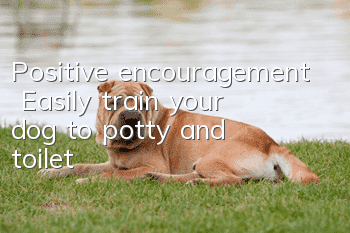Positive encouragement | Easily train your dog to potty and toilet

The first trouble a dog brings to its owner is probably that it urinates and defecates everywhere at home. There are many first-time dog owners who were so annoyed by the "landmines" that could be stepped on everywhere in the home in the first few months that they had no choice but to give their puppies to others. The so-called designated urination point is to let the dog urinate at the owner's prescribed time. place to defecate.
Many people use the "positive punishment" method to train, that is, they punish the dog by beating and scolding it when they find it urinating in an "illegal" place. I have used this method before, and it was successful, but the disadvantage is that it takes a long time, at least two weeks to start to take effect, and it is easy to repeat. In addition, there may be a side effect, that is, in order to avoid being scolded, the dog will cleverly hide in places where the owner cannot see it, such as on the bed to pee, making the problem more serious. A better training method is to use "positive reinforcement", that is, a reward method to encourage the dog to excrete in the correct place.
We already know that the learning rule of animals is that if a behavior is immediately reinforced by environmental factors (such as food rewards, owner's praise, etc.), the frequency of this behavior will become higher and higher. If not reinforced, the behavior will disappear naturally (operant conditioning). Moreover, for dogs, there is no concept of right and wrong, only safety and danger. Therefore, if we use the method of beating and scolding, the dog will come to a wrong conclusion: I can't be convenient when the owner is around, that is very dangerous; it can only be done when the owner is away, that is safer.
After understanding this, you may already understand that the key to toilet training your dog is reward. The key to reward is to be timely, otherwise the dog may not know why he is being rewarded, and may inadvertently reinforce the behavior you do not want. the behavior of. So how can we do it in time?
This requires us to put some thought into it. Puppies generally have the need to urinate after getting up, before going to bed, after a full meal, after games, and after excitement. In addition, the urge to urinate usually occurs 2 to 3 hours after the last urination. Of course, the ideal thing is that you have already trained your dog in the pet box according to the method in the previous section, then things become very simple: put it in the pet box and let it out after 2 to 3 hours. Unless there are special circumstances, dogs will not relieve themselves in their own kennels. When it comes out after 2 to 3 hours, you will usually feel the urge to defecate. Seize these time points and reward him as soon as he urinates in the prescribed place, and you will soon see magical changes.
Indoor fixed-point urination training method:
1. Limit the scope of activities
When the dog has not learned to use “In front of the "toilet", if there is no one at home, limit its activities at home to the "dog proof" area.
Such "dog-proof" areas should be divided into two types of restricted places: "short-term" and "long-term". Places that are similar in size to dogs and have a small range of activities, such as pet boxes, or areas such as small balconies and bathrooms, are "short-term" restricted places. Be careful not to keep your dog in a short-term confinement location for more than 3 hours. In addition, we also need to prepare a "dog-proof" room as a "long-term" restricted place.
If the owner will be away for more than 3 hours, keep the dog in a long-term restricted place, which can be a larger balcony or bathroom, or a pet fence can be used to enclose a special area. Do not place clothing and furniture in this area that may be easily chewed by dogs, and do not lay down carpets, towels and other porous materials that may be mistaken for toilets. Place the pet's crate in this area with soft, comfortable cushions and toys. Open the pet box door so that the dog can enter and exit freely, and place a pet toilet near the pet box. The purpose of keeping a dog in a restricted place is to minimize the possibility of it "making mistakes", improve the accuracy of going to the correct toilet, and facilitate the implementation of "positive reinforcement" for it.
2. Only dogs that have just been "emptied" can move freely outside the "restricted places" at home.
When the owner is at home, if the dog has not gone to the toilet, it should be kept in a pet box. Don’t let your untrained dog run around the house just because you think it’s “poor” to limit its range of activities. That will only make him more "pathetic": you will drive him crazy because he poops all over the house, and you will beat and scold your "poor" dog because of it.
- How to correct puppies chewing things randomly
- Golden Retriever body type standards
- Why do dogs always lie on the ground?
- How to train a Chihuahua to be obedient
- What is the best medicine for golden retriever kennel cough?
- What are the causes of vomiting in dogs?
- How to quickly identify a Husky’s personality?
- How to get rid of dog odor
- What should you pay attention to when your Husky is pregnant?
- Why can’t dogs eat mutton?



